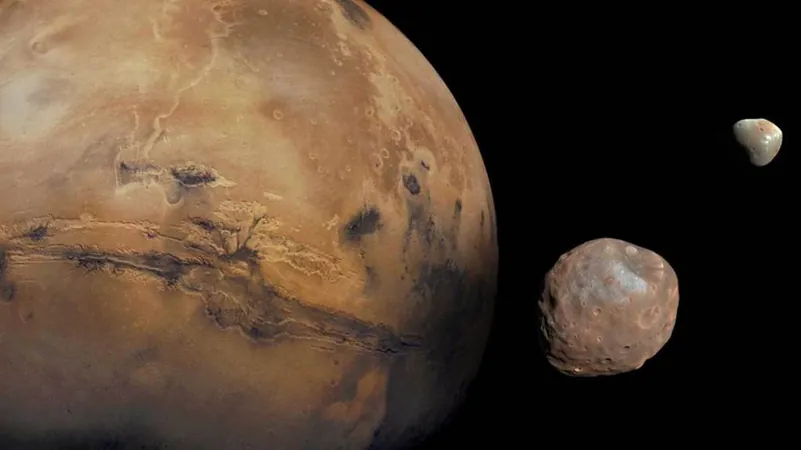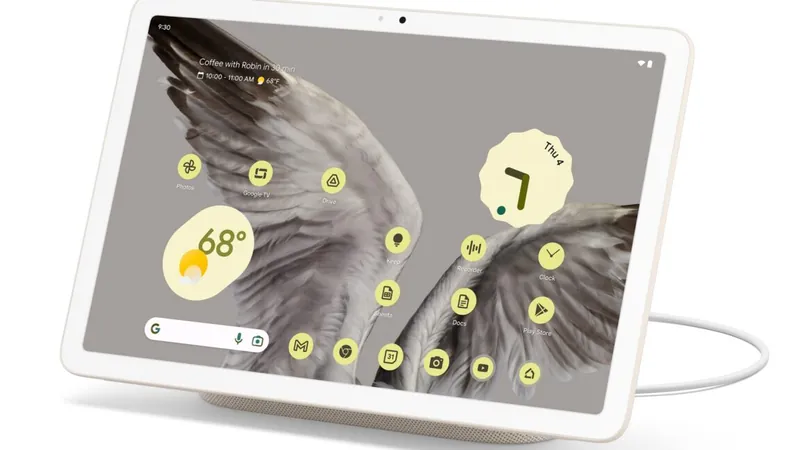
Groundbreaking Study Unravels the Mysteries of Mars’ Moons: Phobos and Deimos Origin Explained!
2024-11-24
Author: Emily
A remarkable new study by NASA scientists has shed light on the enigmatic origins of Mars' moons, Phobos and Deimos. Utilizing cutting-edge supercomputer simulations, the research team, led by Jacob Kegerreis, has proposed a compelling theory involving the disruption of an asteroid that once roamed the asteroid belt before coming too close to Mars.
Ever since the discovery of Phobos and Deimos in 1877, their origins have been a subject of intense speculation among astronomers. The new study suggests that the intense gravitational forces of Mars could have torn apart a rogue asteroid, scattering its remnants into hundreds of thousands of rocky fragments around the planet. This theory is significant as it introduces a new perspective in understanding how these peculiar moons came into existence, diverging from the previously favored notions.
Kegerreis and his team's simulations examined a variety of variables—such as the asteroid's size, spin, speed, and its proximity to Mars during the disruptive event. By utilizing advanced computing systems from Durham University, they employed two distinct simulation codes: one for modeling the asteroid's destruction and another for tracking the subsequent debris orbits. Their findings revealed that enough material could coalesce from the fragments to form moons similar to Phobos and Deimos.
Interestingly, this research challenges two predominant theories regarding the origins of these Martian moons. The first theory posits that Phobos and Deimos were once independent asteroids that became captured by Mars' gravity. The second theory suggests that a massive impact on Mars could have propelled surface material into orbit, leading to the moons' formation. However, the second scenario struggles to explain Deimos' extensive orbit, where current understanding indicates that any debris from a surface impact would remain closer to Mars.
"Kegerreis et al.'s models successfully account for the large orbital distance of Deimos by suggesting that the debris created during the asteroid's disruption could extend far enough to allow for the formation of both moons at their respective distances from Mars," says co-author Jack Lissauer of NASA Ames Research Center.
The implications of this groundbreaking research extend beyond Mars. The simulations offer the opportunity to explore the formation of various moons within our solar system and help us understand the dynamics of early celestial encounters—a critical period that shaped the current structure of our solar neighborhood.
As the team plans to refine their models further, they aim to investigate the structure of the debris disk from which Phobos and Deimos emerged. This work could complement upcoming missions, including the Martian Moons Exploration (MMX) mission led by Japan’s Aerospace Exploration Agency (JAXA), scheduled for launch in 2026. MMX will endeavor to analyze these moons and collect samples that might ultimately provide insights into whether Phobos and Deimos were once free-floating asteroids or the remnants of a violent disruption event.
“The discovery of their origins is not just a remarkable achievement in astrophysics; it could potentially unravel the unique characteristics of our neighboring celestial bodies,” Kegerreis emphasizes. With continued research, scientists are excited about revealing more about these intriguing moons and their role within the greater tapestry of our solar system.
Stay tuned as we anticipate the insights and revelations that the MMX mission will bring upon its journey to unlock the secrets of Phobos and Deimos!









 Brasil (PT)
Brasil (PT)
 Canada (EN)
Canada (EN)
 Chile (ES)
Chile (ES)
 España (ES)
España (ES)
 France (FR)
France (FR)
 Hong Kong (EN)
Hong Kong (EN)
 Italia (IT)
Italia (IT)
 日本 (JA)
日本 (JA)
 Magyarország (HU)
Magyarország (HU)
 Norge (NO)
Norge (NO)
 Polska (PL)
Polska (PL)
 Schweiz (DE)
Schweiz (DE)
 Singapore (EN)
Singapore (EN)
 Sverige (SV)
Sverige (SV)
 Suomi (FI)
Suomi (FI)
 Türkiye (TR)
Türkiye (TR)